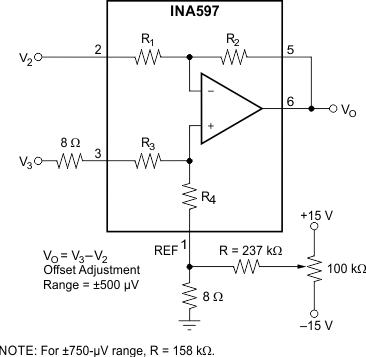SBOS385B August 2019 – April 2021 INA597
PRODUCTION DATA
- 1 Features
- 2 Applications
- 3 Description
- 4 Revision History
- 5 Device Comparison Table
- 6 Pin Configuration and Functions
- 7 Specifications
- 8 Detailed Description
-
9 Application and Implementation
- 9.1 Application Information
- 9.2
Typical Applications
- 9.2.1 Basic Power-Supply and Signal Connections
- 9.2.2 Precision Instrumentation Amplifier
- 9.2.3 Low Power, High-Output Current, Precision, Difference Amplifier
- 9.2.4 Pseudoground Generator
- 9.2.5 Differential Input Data Acquisition
- 9.2.6 Precision Voltage-to-Current Conversion
- 9.2.7 Additional Applications
- 10Power Supply Recommendations
- 11Layout
- 12Device and Documentation Support
- 13Mechanical, Packaging, and Orderable Information
Package Options
Mechanical Data (Package|Pins)
Thermal pad, mechanical data (Package|Pins)
- DRC|10
Orderable Information
9.2.1.2.2 Offset Voltage Trim
The INA597 is production trimmed for low offset voltage and drift. Most applications require no external offset adjustment. Figure 9-2 shows an optional circuit for trimming the output offset voltage. The output is referred to the output reference terminal (pin 1), which is normally grounded. A voltage applied to the REF pin is summed with the output signal. This configuration can be used to null offset voltage. To maintain good common-mode rejection, make sure the source impedance of a signal applied to the REF pin is less than 8 Ω. For low impedance at the REF pin, the trim voltage can be buffered with an op amp, such as the OPA177.
 Figure 9-2 Offset Adjustment
Figure 9-2 Offset Adjustment